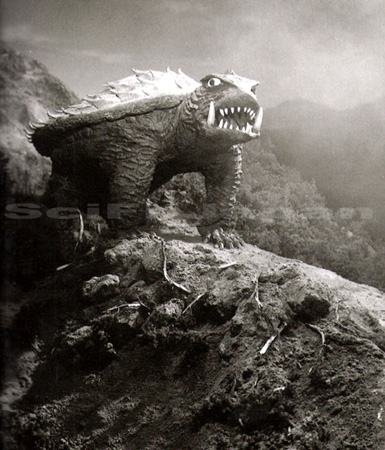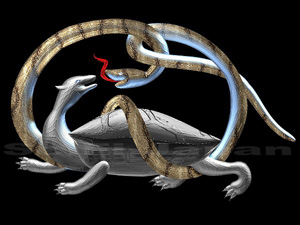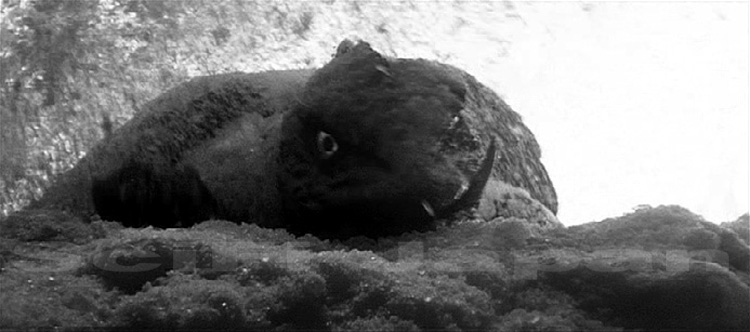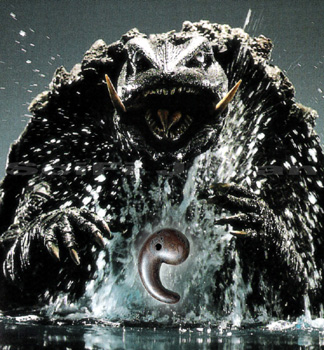Author: Sean Kotz of CreatureScape Sources: •Chevalier, Jean and Alain Gheerbrant. A Dictionary of Symbols. Blackwell Publishers: Cambridge, Mass. (1994). •Cooper, J. C. Dictionary of Symbolic and Mythological Animals. Thorsons: London (1992). •MacKenzie, Donald A. Myths of China and Japan. Gramercy Books: New York (1994).
Beginning with 1965’s GAMMERA THE INVINCIBLE, American audiences have had a hard time getting over the fact that, obviously, Gamera is a giant turtle. In fact, in the Harris Associates Incorporated/NTA release for American viewers, devotes no less than five minutes of film time to debating this “hallucination.” Every English speaking character who hears the story scoffs and dismisses the premise as silly. In other words, even the Americans in the film can’t believe in a “giant turtle” and initially Gamera’s only defender is a rather eccentric (but genuinely comical) Dr. Contrare. Part of the problem is that Godzilla, Gamera’s more famous and successful predecessor, made much more sense on this side of the Pacific. A prehistoric dinosaur with a lethal dose of radioactivity, Big G. naturally fit the Western image of a fire-breathing dragon. Moreover, dinosaurs had long been silver screen villains in the US—since 1925, in fact. And nuclear mutation and dinosaurs were already hot themes in theaters in the 1950s. THE BEAST FROM 20,000 FATHOMS paved the way for GOJIRA in more ways than one. Another part of the problem is that back in 1965 any kid with a dollar in his pocket and a glass bowl could become the owner of a cute, inoffensive and decidedly non-deadly pet turtle. Apparently, the same was true in Japan since Toshio (a.k.a. “Kenny”) has more to fear from his micro-managing schoolteacher than his friend in the terrarium. So, if that is the case, why then, is Gamera a turtle? How is it that someone finally said, “I got it! Why not a giant turtle?” and no one shot the idea down? The answer lies in the complicated history and mythology of Japan—much of which is inherited from older Chinese traditions. The beginning point would seem to be the Chinese concept of the Ssu Ling, or Four Guardians of the Four Directions. Known as the Shijin in Japan, there are four celestial animals that maintain balance in the world as guardians. In the south, is the red phoenix (Suzaku); in the east is the blue dragon (Shiryu); in the west, the white tiger (Byakku) stands guard; and in the north, Genbu, the black tortoise, reigns supreme.
To put it bluntly, Genbu is Gamera. A quick examination of the facts makes the connection quite clear. To begin, Genbu is known as the Black Warrior of the north. In more recent times, he has been depicted in a human form, but traditionally Genbu is rendered with a snake’s head and tail on the body of a tortoise. Gamera, of course, is first awakened in the Arctic and his physique clearly includes an extended neck and dragging tail. Moreover, as a tortoise, Genbu is symbolically associated with longevity, wisdom and strength, since throughout Asia (and elsewhere) several mythic tales hold that the world is supported on the back of a tortoise. According to Jean Chevalier and Alain Gheerbrant’s Dictionary of Symbols: "The task of supporting the universe and of being the pledge of its stability relates the tortoise to the greatest gods…The association of primeval waters with regeneration derives from nocturnal and lunar symbolism, the tortoise in China symbolizing both north and Winter…The well-known longevity of both tortoises and turtles is so well known as to lead them to be associated with notions of immortality." (1017) Other researchers of symbolism and mythology, like J. E. Cirlot and J. C. Cooper, concur. As Cooper reports, in addition to being associated with regeneration and time itself, it also symbolizes “primordial chaos” (242) and among the Ainu people of Hokkaido, the great tortoise is a messenger from the god of the sea and must be venerated and respected or there can be terrible consequences.
This certainly sounds like Gamera, doesn’t it? As we`ve noted, Gamera emerges from the Arctic (which is about as north as north gets). Having survived countless millennia, Gamera represents longevity through sheer existence, but more than that his immortality seems to be implied in the very title: GAMMERA THE INVINCIBLE. Regeneration is another attribute of Gamera seen in all of the films and his strength and connection with the waters is unquestionable. “Primordial chaos” seems to fit the bill as well with Gamera, but there is the element of wisdom as well. Gamera’s connection to Toshio and subsequent misunderstood children demonstrates the inherent guardian nature of Genbu as well as his desire to preserve the world itself. According to the traditions of both China and Japan, after 1,000 years, the tortoise can speak the language of humans, which helps explain why Gamera seems to pay attention when the pipsqueaks squeak.
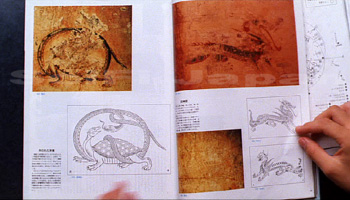 A book describing the Four Guardians, including Genbu, is featured in GAMERA 3: REVENGE OF IRIS. ©1999 Kodakawa Pictures.
A book describing the Four Guardians, including Genbu, is featured in GAMERA 3: REVENGE OF IRIS. ©1999 Kodakawa Pictures.Another element we have picked up in this mythological symbolism is the reference to Hokkaido and the Ainu people. This too seems a little more than coincidental, especially since Gamera heads straight for the icy shores of Hokkaido, Japan’s northern most island. Also, the Ainu bear a cultural and to some degree, physical resemblance to Inuit culture in its relationship to the sea and the correlative mythology. This connection may seem a bit loose, but there is an interesting myth throughout Asia of the Islands of Paradise, similar to the Greek Isles of the Blest, that further connects Hokkaido to the oldest traditions of mythical tortoises. According to Donald Mackenzie’s Myths of China and Japan, the islands vary in number from ten to three, but tend to be located in the Eastern ocean and are most commonly seen as five islands. In one interesting story, a giant once happened upon these five islands and rather indifferently set two adrift, which floated to the north. These islands were set loose when he trapped the giant tortoises that held them in place. Is it possible that Hokkaido and perhaps Onshu were the mythical islands set adrift northward when separated from their guardian tortoises in the story above? Furthermore, the inhabitants of the islands were said to be quite hairy and in some tales, the men had faces like dogs. “Evidently, the legends about the fabled islands became mixed up with account of the distant islands of a bearded race of seafarers” (114), a description that fits both the culture and genetics of Hokkaido’s Ainu.
At this point, we might consider the relationship of Gamera to Atlantis, a trait that is suggested in the Showa films and flat out declared in the Heisei films. Atlantis is a Western name, of course, for one of the lost isles of mythology, but it is used frequently in Asian cinema as well. As we have seen, in Asian tradition, the immortal islands are supported by divine tortoises. We also know that by the 1990s, Gamera was more of a biomechanical creation of the Atlantians to act as a guardian against the Gyaos. Thus, there is at least a connection if not a direct linage to the oldest myths about tortoises from China to Japan. If Hokkaido can be mythically connected to the original lost Isles of Paradise, as I have suggested above, that would make Atlantis a sister to them both in stories stretching back hundreds of years--not merely a few decades. It would also go a long way to explaining why the guardian turtle of Atlantis takes a special interest in Japan from 1965 forward without it being such a stretch to the Japanese mind. And, all this brings us back to Genbu, the guardian turtle of the north. It may still seem strange to the Western mind to think of the tortoise or turtle as a monster, but essentially Gamera has always been more of a guardian than a demon. He also has an undeniable connection to the north in general and Hokkaido in particular, making the Ainu turtle god even more relevant. And, while I am not suggesting that Gamera is the product of intentional scholarship and mythology (the original idea was to make some money), the origins of Gamera are deeply lodged in the Japanese mythos, and therefore, the Japanese psyche.


